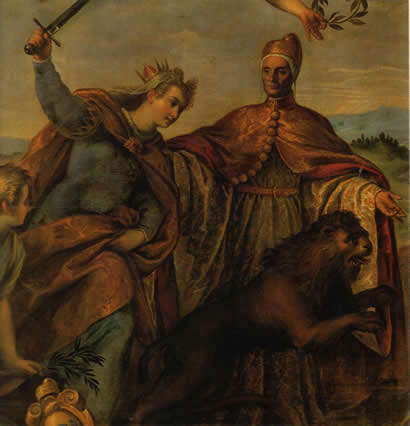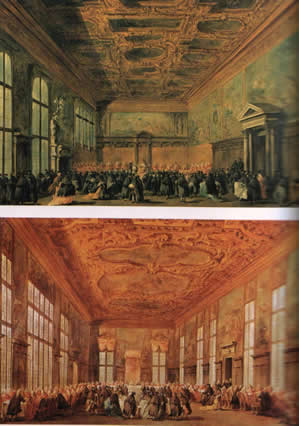The 16th Century was one of the most difficult periods in the one-thousand-year-old history of the Venetian Republic: the war against the League of Cambray (1507-08) , the conquest of Cyprus by the Turks (1570-73) and the Plague (1575-76).
Nevertheless, the Republic recovered quickly and was in fact the only Italian city to remain free of the general crisis affecting the other Italian States.Venice is cosmopolitan city, which attracted and hosted subjects from its domain - the "Stato da Terra" (mainland) and the "Stato da mar" - but also foreigners. There were flourishing Greek , Armenian , Albanian, Jewish communities. The nation "todesca" – Germans plus Bohemians, Poles, Hungarians and people from the Trentino area - had built their own fondaco in the 13th Century in Rialto that was promptly rebuilt after a fire of 1505. Turkish, Albanian and Bosnian merchants had had a place of shelter since 1574 at the "Osteria dell’Angelo" in San Matteo di Rialto (the Turks were only granted the right to have a warehouse, the Fondaco dei Turchi, in 1621, in the former Palazzo Pesaro on the Canal Grande at San Stae).
With trade and sea traffic once again prosperous in the 16th Century , Venice also "recreated" the urban-architecture of the city, where each social class found their own space to live and work.
Culture was an important part of life in Venice.
Printers were very active, leaving to posterity many literary , poetical and musical works.
Science, too, was important (medicine, mathematics, plumbing, etc.) at Padua University and the “Scuola di Rialto”.
Venice also patronised painters of the likes of Gentile and Giovanni Bellini, Giorgione, Tiziano , Lorenzo Lotto, Paolo Veronese , Canaletto .
All citizens – from the noble families to the lowest ranks – took part in representations of the power of the state (theatre and religious ceremonies). Major political and religious public holidays were renewed each year - in 1578 the magical Night of the Redeemer , on the eve of the third Sunday in July, was added to celebrate the city’s liberation from the plague – to the more modest, but no less sincerely enjoyed, popular events. In addition to the "freschi" (processions at sunset) along the city’s canals, there were the boat parties organised by the Compagnia della Calza , with sumptuous banquets, tournaments, naumachiae, balls and, of course, the regate: boat races organised during visits by important dignitaries.
Even the "campi" (squares) became natural theatres for "bull hunts" - reserved for the corporation of "beccheri" (butchers) - or even bears.The factions of Castellani (inhabitants of the Sestieri of Castello, San Marco and Dorsoduro) and Nicolotti (sestieri of San Polo, Santa Croce and Cannaregio) fought each other in the “guerre con i bastoni” (wars with sticks) and "battagliole dei pugni" (fist fights) which often degenerated into bloody brawls with dead and wounded.
Then there were the spectacular “Forze d'Ercole” (Herculean trials) : human pyramids, dangerous acrobatic exercises accompanied by music, not only in Piazzetta San Marco and in the [campi], but also on the Canal Grande, on rafts sitting on boats (known as "peate"). Not to mention human pyramids balancing on just two gondola oars .
Michela Dal Borgo













